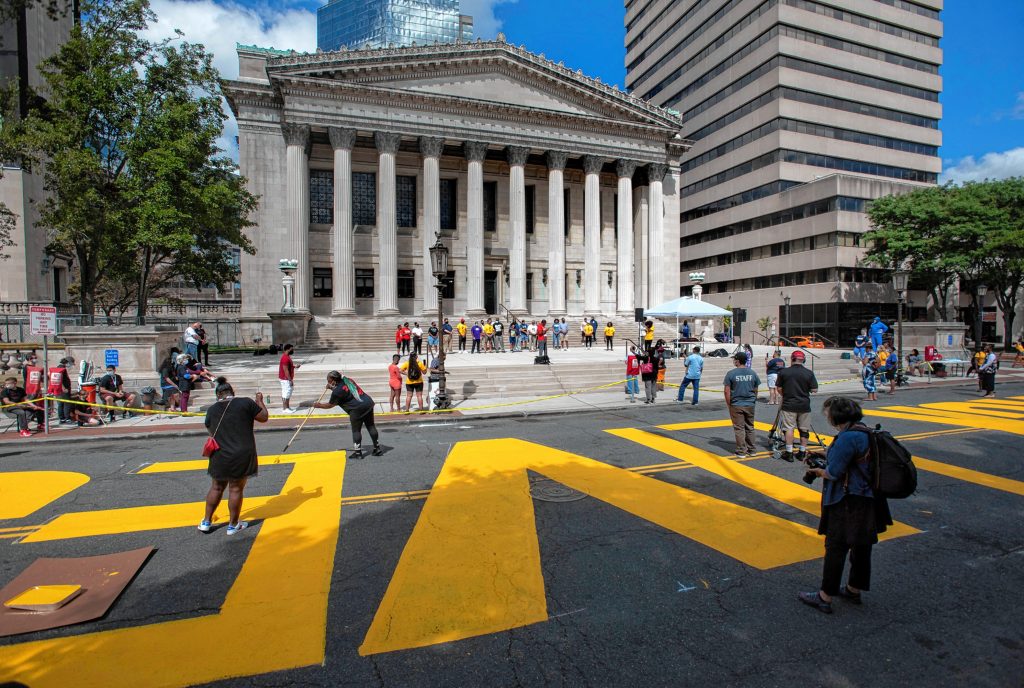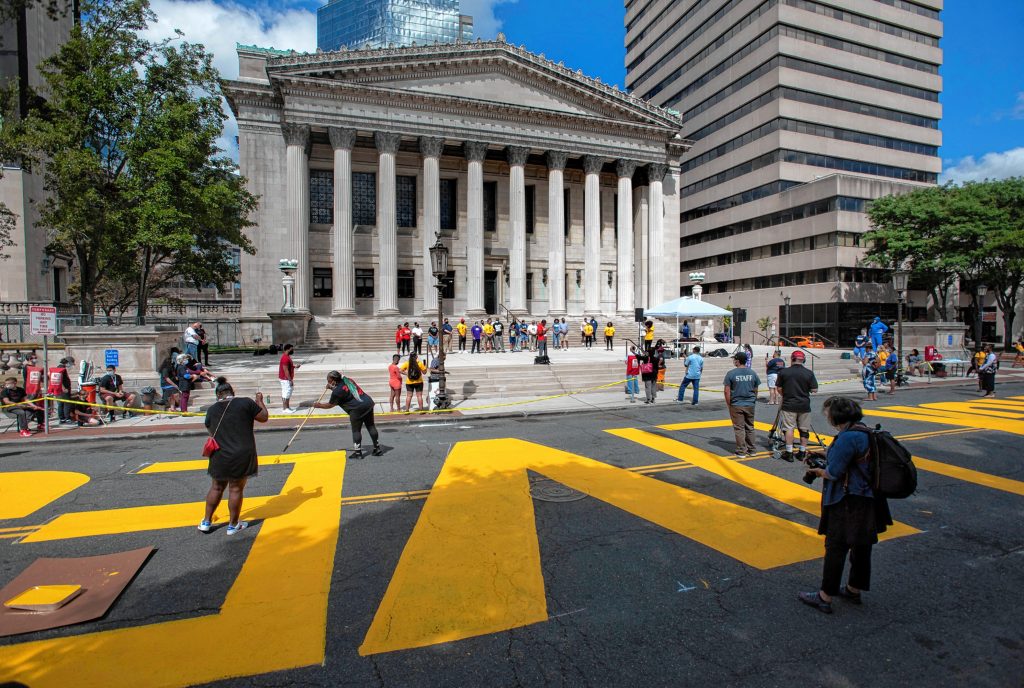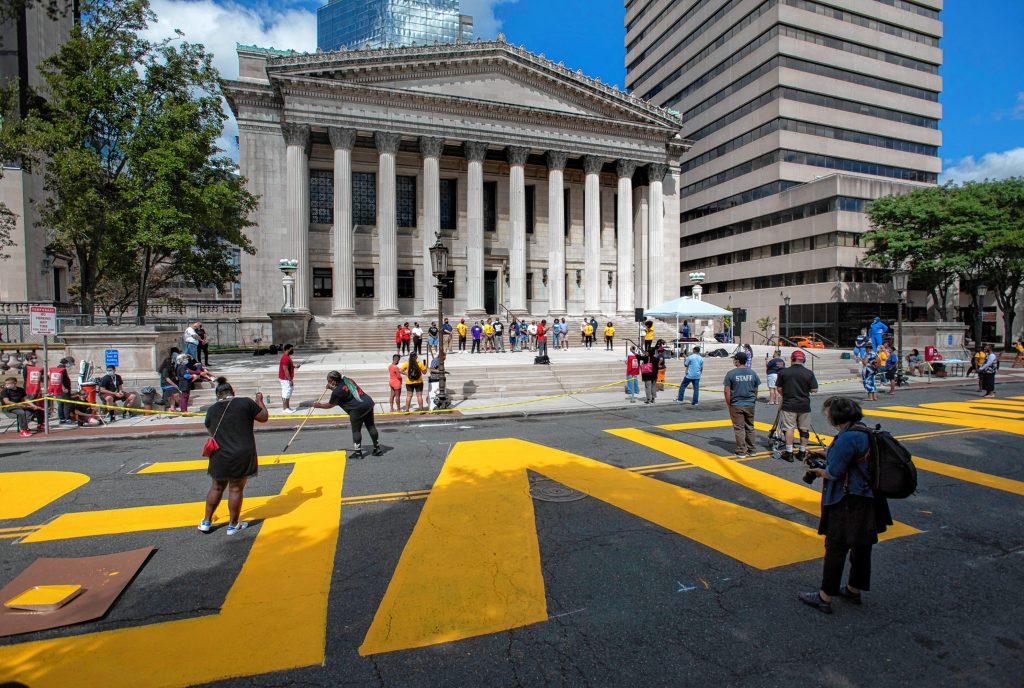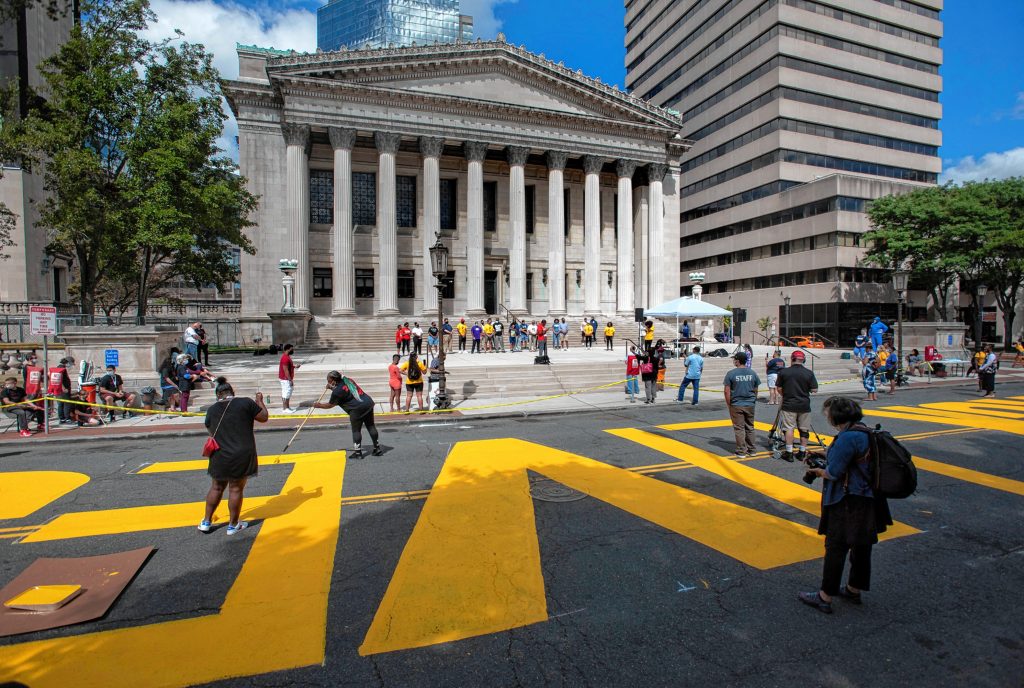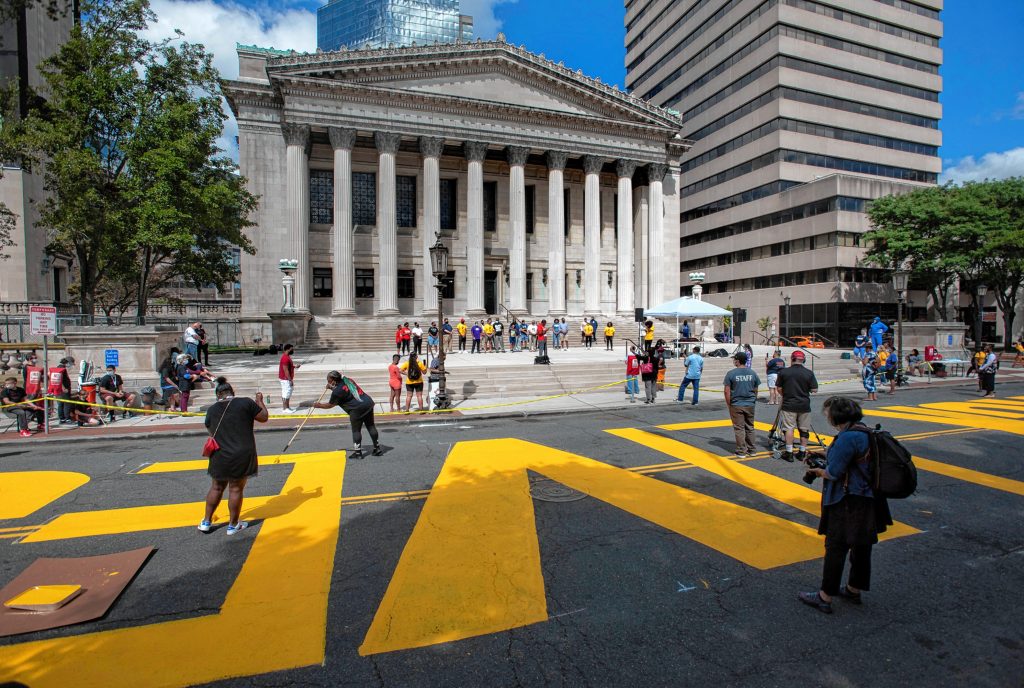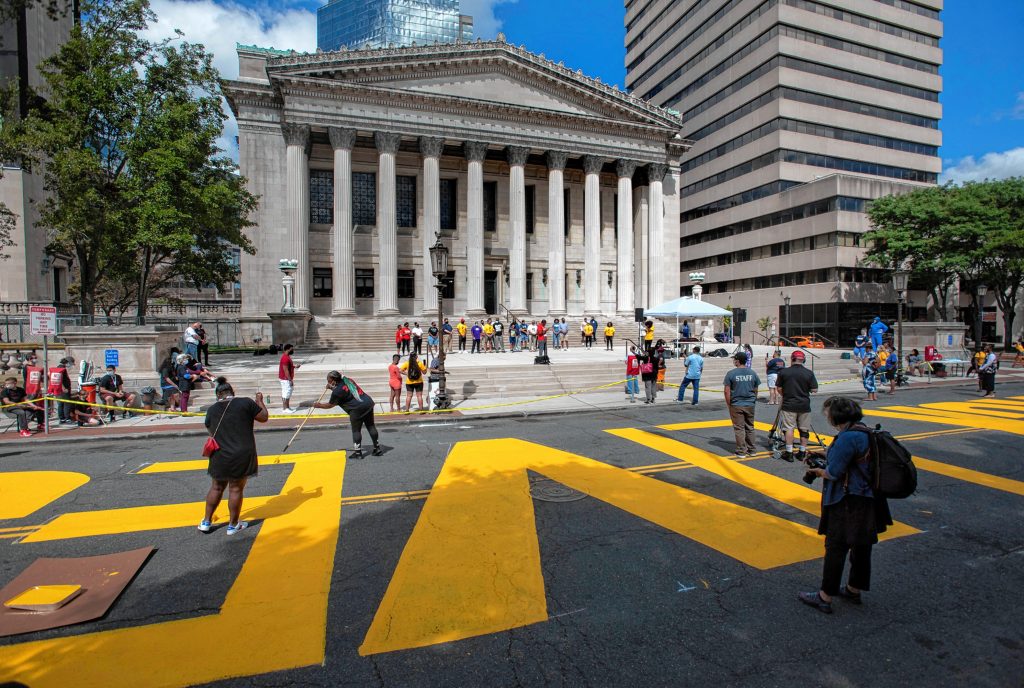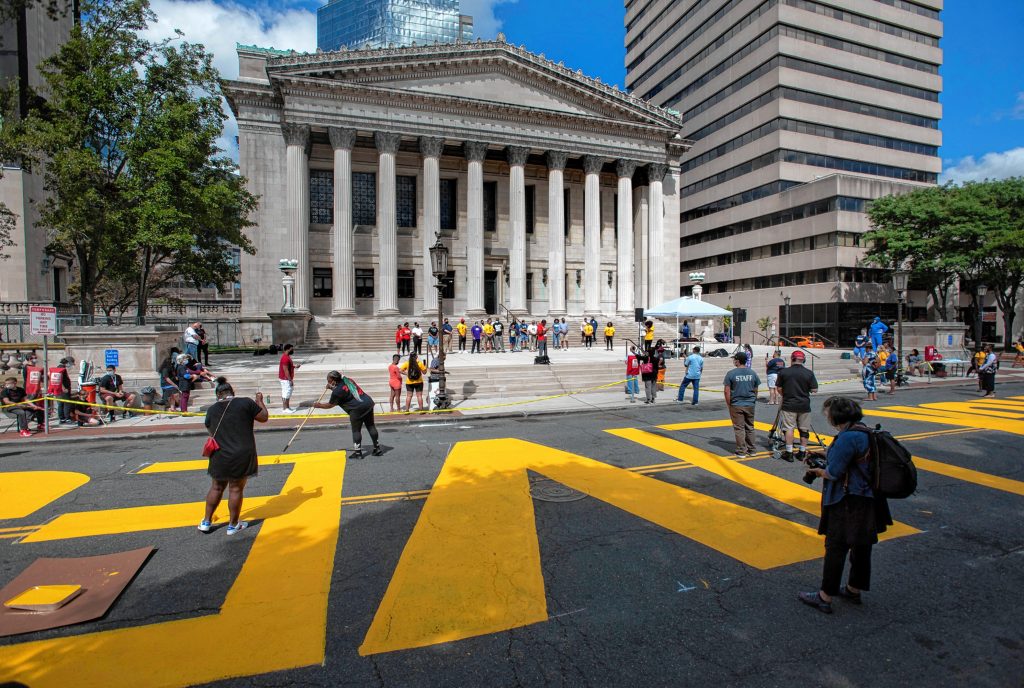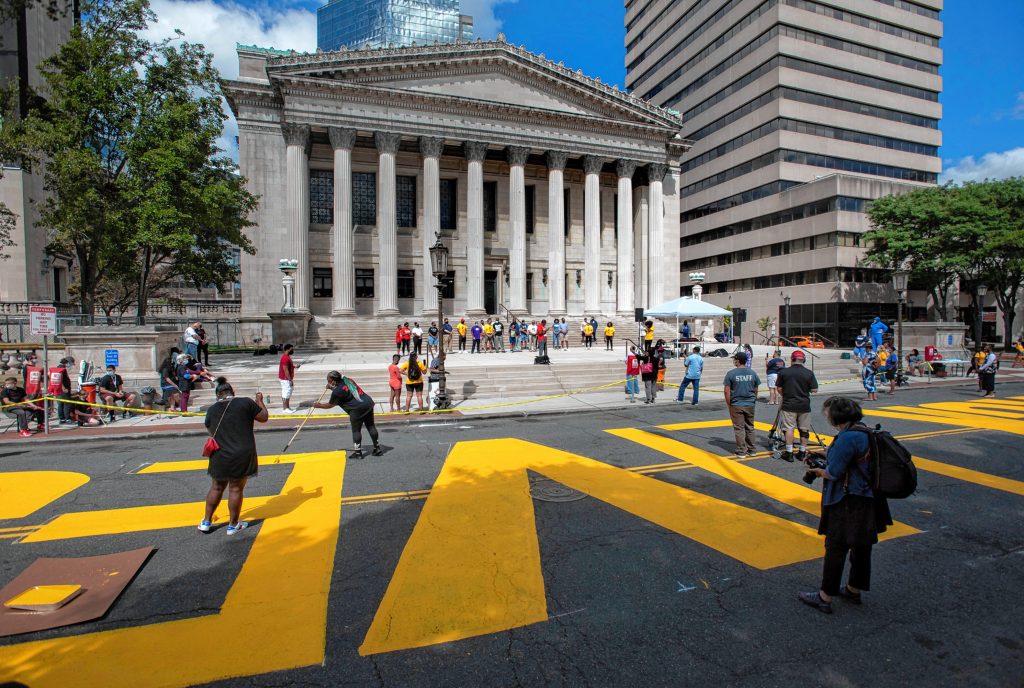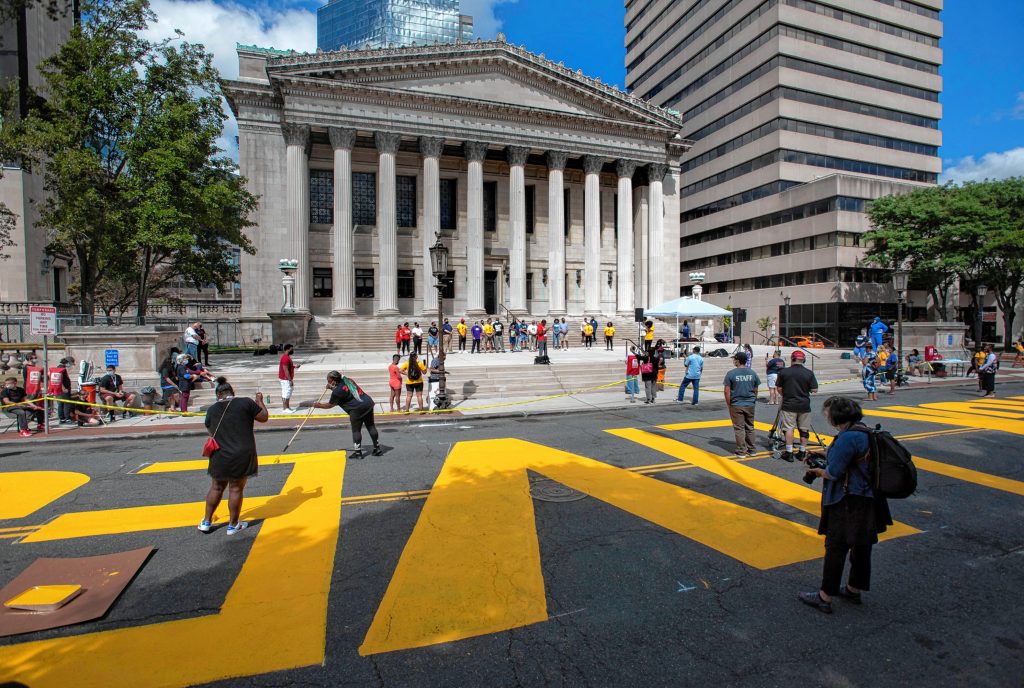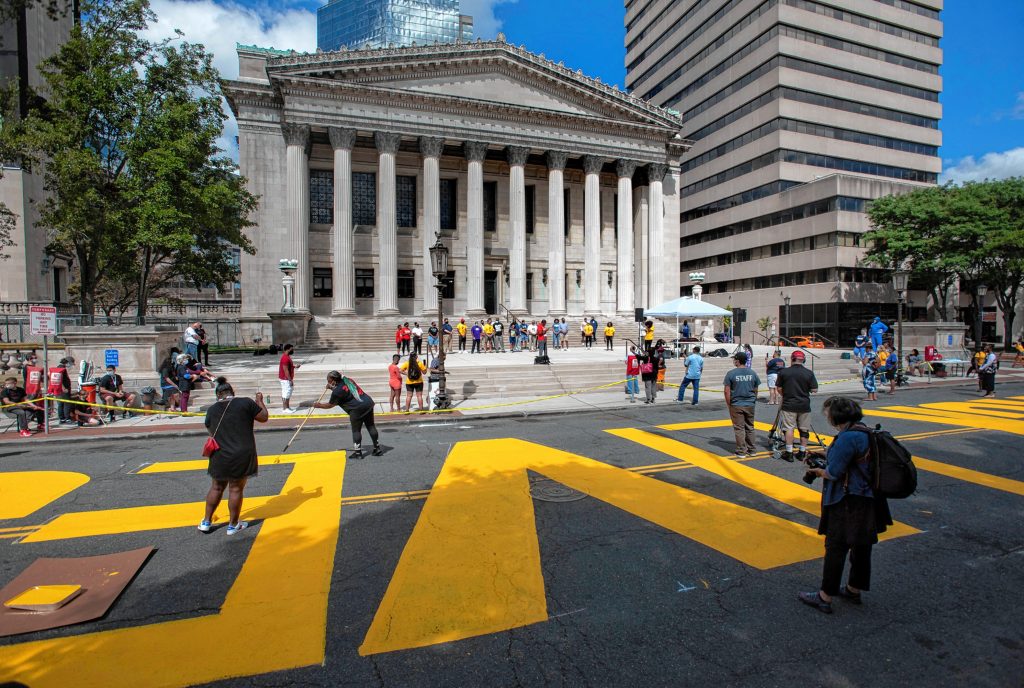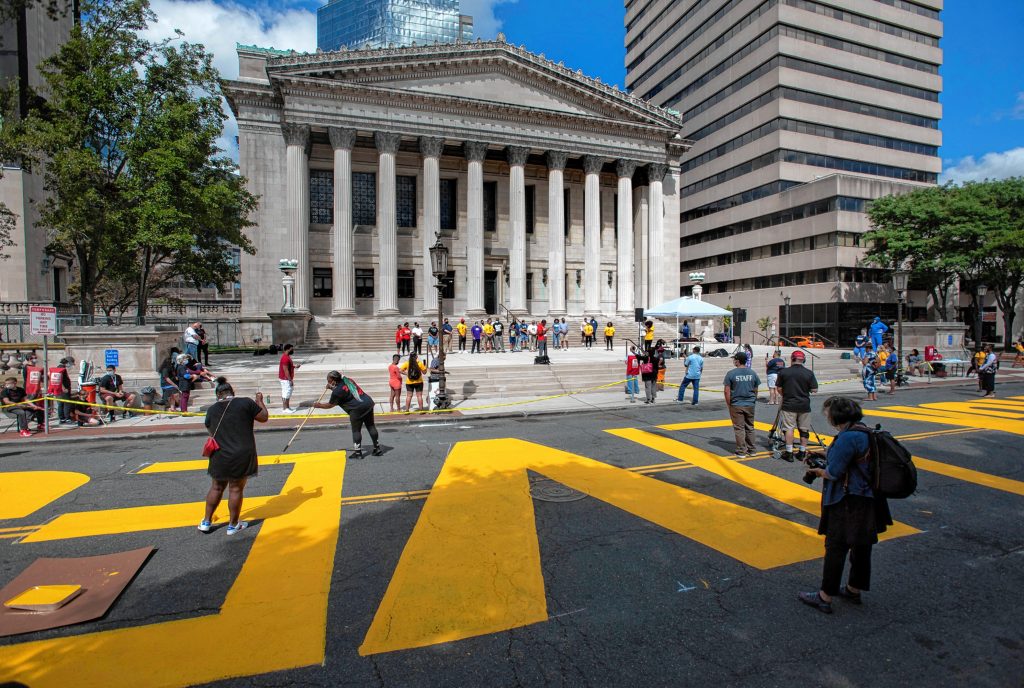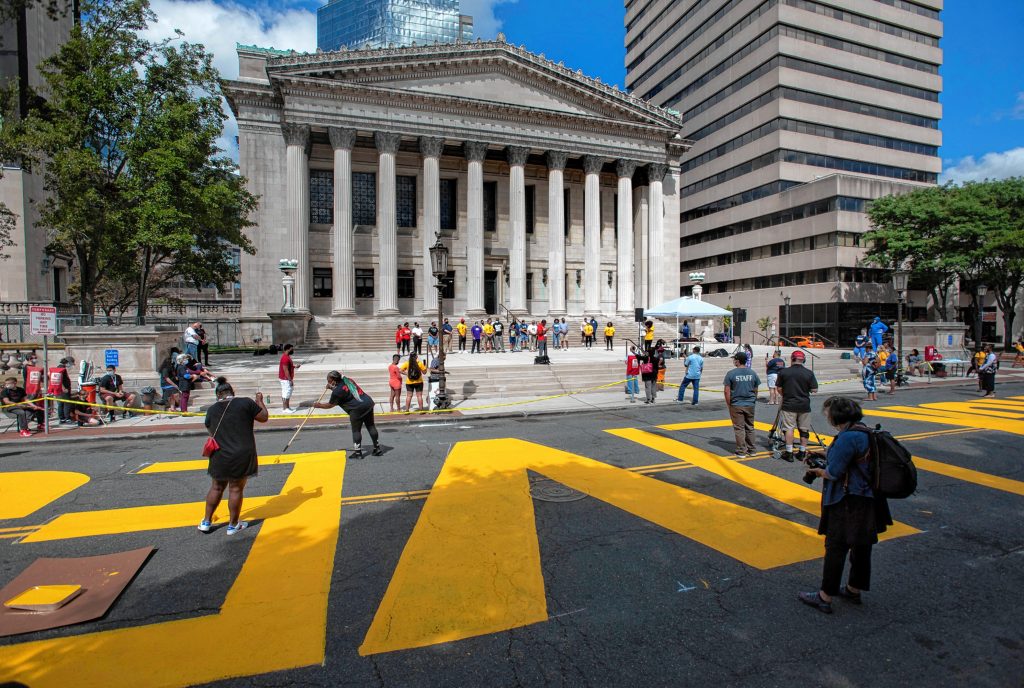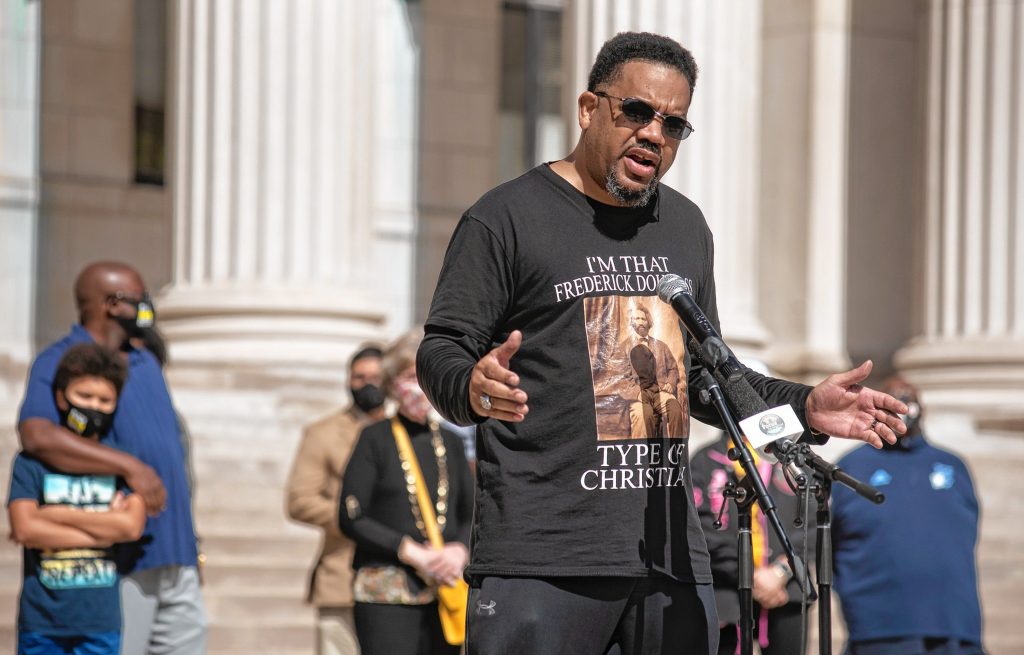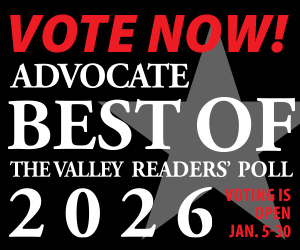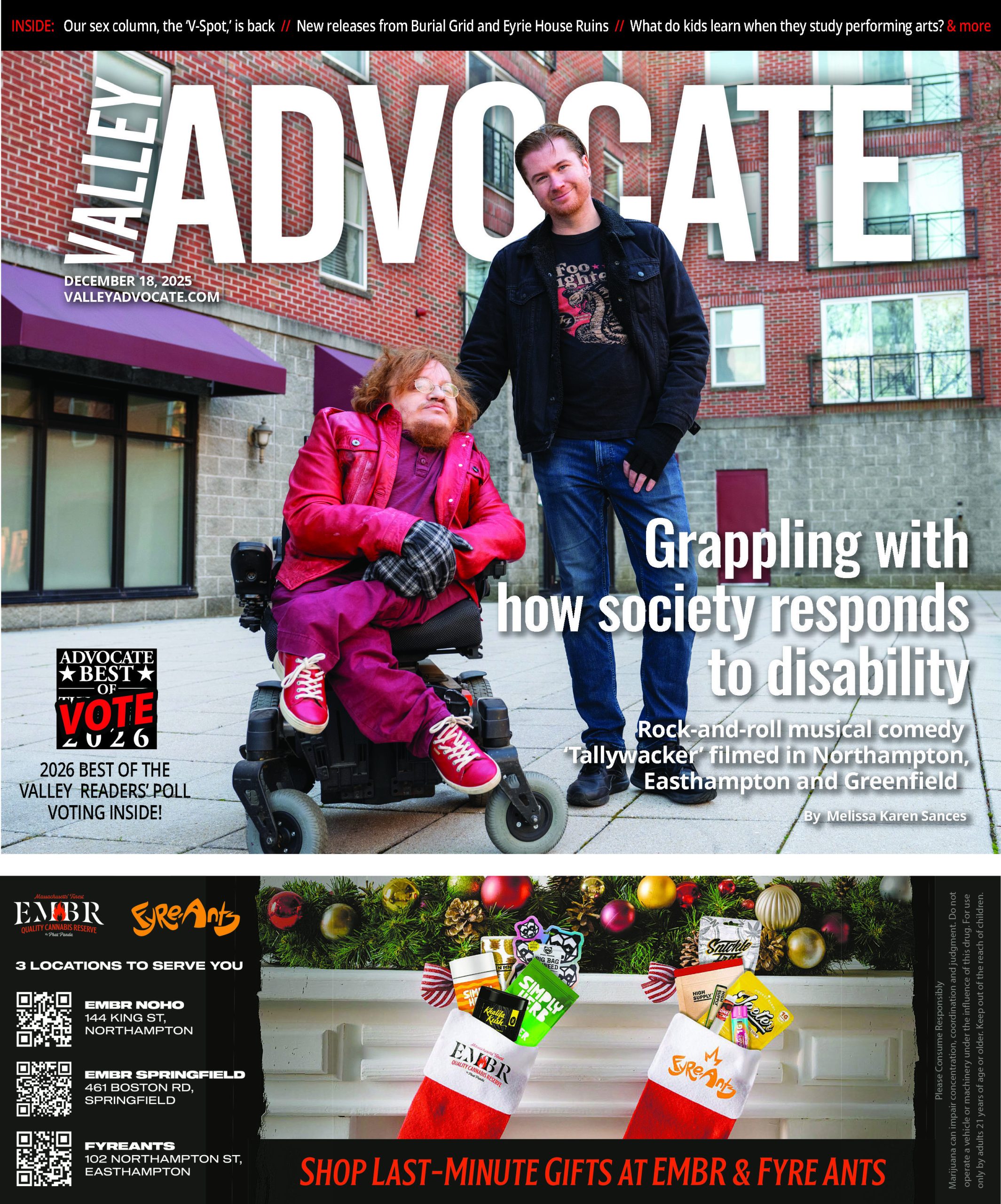Across Court Square in the city of Springfield the words, “BLACK LIVES MATTER,” are painted on Court Street in 20-foot-tall, bright yellow letters — a powerful symbol of a movement that has taken on a new urgency nationally and in our own backyard in this chaotic year of 2020.
Despite the mural’s defacing by tire tracks the day after its creation on Sept. 12, it remains for many a symbol of the ongoing protests against police brutality, systemic racism and the long list of people of color who’ve been killed by police officers, highlighted this year by George Floyd in Minnesota and Breonna Taylor in Kentucky.
Springfield City Councilor Tracye Whitfield, who organized the creation of the mural, thinks the affirmation that the lives of people of color matter in her own community is an important historical moment.
“It’s a form of protest and it says, ‘We’re going to fight for what’s right,’” says Whitfield, noting that 40 volunteers and the mural arts festival organization, Fresh Paint, helped create the mural last month. “And so, I think the symbol needs to be there so when people ride down the street and see the Black Lives Matter mural … In the eyes of some police, Black lives don’t matter the same as white lives. We really want to create that awareness.”
While it’s great to raise awareness of racial injustice through murals, protests and speakouts, activists of the years-in-the-making movement say much more work needs to be done to safeguard civil rights and racial justice, especially in the region’s largest city. Many are pointing to a bombshell report from the U.S. Department of Justice, released July 8, as proof changes need to be made. That report shined a light on how the Springfield Police Department’s Narcotics Bureau engaged in civil rights violations and police brutality over a number of years.
The report has prompted several developments since its release. Some of those include:
Mayor Domenic Sarno and city staff organized an online Springfield Policing Roundtable, a group of experts who are seeking resident input as they move forward with implementing the recommended changes outlined in the report.
Activist groups involved in trying to create change in the city, such as the Facebook group “Real Recognize Fake,” have organized a series of protests called “Club SPD” across from the Springfield Police Department in which demonstrators have read the DOJ report out loud three times over the course of 20 hours to put pressure on creating change.
Two weeks ago, on Sept. 29, the City Council voted to sue the city of Springfield for Sarno’s inaction on the council’s previous vote to revive a five-member citizen Board of Police Commissioners. Such a commission had been used by the city in previous decades before switching to a police commissioner model.
The DOJ report
The DOJ’s investigation into the SPD’s Narcotics Bureau, released this summer after an investigation that began on April 13, 2018, identified a pattern of excessive force by officers and “systemic deficiencies in policies, and accountability systems in training,” according to the report’s executive summary.
“For example, unlike most other police departments, SPD policies do not require officers to report ‘hands on’ uses of force such as punches or kicks,” the report states. “This practice enables Narcotics Bureau officers to routinely avoid reporting any use of hands-on force or to submit vague and misleading reports documenting their uses of force.”
Additionally, the investigation also found examples where Narcotics Bureau officers falsified reports and attempted to hide their use of force.
“From 2013 to 2018, command staff did not make any referrals in cases involving the Narcotics Bureau; indeed, not a single such referral was made throughout the entire department,” the summary reads. “Further, while the Internal Investigations Unit (IIU) has investigated some excessive force complaints made by members of the public, its investigations lack critical content needed to determine if any allegation should be sustained. This has resulted in zero sustained findings of excessive force against any Narcotics Bureau officer in the last six years.”
The report is a comprehensive review of 114,000 pages of SPD incident reports, investigative reports, policies, training materials and internal documents, as well as interviews with officers, city officials and community members conducted by two law enforcement experts, both of whom have a background in reviewing use-of-force incidents.
The findings in the report led to the United States indicting veteran Narcotics Bureau Sgt. Gregg Bigda in October 2018 for color-of-law violations related to a 2016 arrest and beating of two juveniles. The indictment alleges that the sergeant kicked one of the youths in the head, spat on him and said, “welcome to the white man’s world.” It’s alleged that Bigda also threatened to crush one of the youth’s skulls and “f— get away with it,” the DOJ report states.
Bigda is charged with three counts of deprivation of civil rights such as excessive force and abusive interrogation charges and one count of filing a false report in an internal investigation. His case is currently on trial and he faces up to 15 years in prison if convicted.
Recommendations
The report lists four recommendations to implement change in the police department. These include:
Enhancing force reporting and review procedures.
Adopting new use-of-force training.
Reviewing and revising Internal Investigations Unit policies and training.
Increasing accountability mechanisms.
In response to the report, Mayor Sarno created the police roundtable, an effort that began via Zoom Sept. 26 and includes Springfield Police Commissioner Cheryl Clapprood and other city officials. Sarno said during that first meeting that the roundtable would be crucial to “enhance police and community relationships” and implement the reforms recommended by the DOJ.
“A number of reforms are already being moved forward on, but there’s much more work to be done,” Sarno said. “We need to hear you. We want to listen to you and we want to get some input. You’re invaluable as a partnership as we continue to move the city of Springfield forward.”
Clapprood said her department welcomed changes to address police brutality.
“We understand the problems and since February of 2019, we have been trying to move in the right direction to gain the confidence of the citizens of Springfield … It is definitely a work in progress,” she said at the meeting. “You don’t turn over a large department in the way we do things with 511 sworn officers. It takes time and I think we have gone quite a ways and in the right direction. A lot of incidents brought up by the DOJ, we’ve looked and corrected those.”
Sarno and Clapprood recently spoke with residents over Zoom to hear questions about the DOJ recommendations, which they were told would be answered in a follow-up session. Although Sarno did not list ongoing reforms at that meeting, he referred residents to the city’s website, which lists changes made to the department.
One change in the works, Clapprood says, is having officers wear body cameras. Training on the cameras began in May and by the end of the year, all officers are expected to wear them. Currently, about 340 officers are wearing body cameras, she said.
The website also lists an overhaul of policies and procedures within the SPD, avenues for citizens to file misconduct complaints online, enhanced reviews of Use of Force Complaints, a Narcotics Division overhaul with new protocols and procedures, and a focus on de-escalation training.
Roundtable
The Policing Roundtable is being overseen by Springfield-native Roderick Ireland, a retired judge and former chief justice of the Supreme Judicial Court of Massachusetts.
“The mayor has asked me to advise him on reforming the police department,” Ireland says. “Our agreement is that I will tell him the good, the bad and the ugly. I am not in this for window dressing. I am in this to help the city that I love move forward.”
One of the speakers during the Zoom meeting was 2019 Springfield mayoral candidate Yolanda Cancel, a former Boston police officer who ran for mayor last year after her son was hospitalized for a gunshot wound.
“I know that the police commissioner and everyone is doing their best for the police and community relations,” Cancel says. “What is it that’s being done to make sure that your officers are also following in line, right down to your patrolman? How are you holding them accountable to make sure of this?”
Whitfield, who also participated in the Zoom meeting, later said she thought Sarno was “controlling the narrative.”
“I think a dialogue and a conversation is talking to each other back and forth and answering questions as they’re posed to you and that didn’t happen,” she noted. “You can’t call something a conversation when it’s just asking questions and not getting many answers … Saying it was a community conversation is false pretense because that’s not what it was at all.”
Board of Police Commissioners
Meanwhile, the Springfield City Council voted at a special meeting on Sept. 29 to retain the pro-bono legal counsel of attorneys Thomas Lesser and Micahel Aleo to represent the council on the ongoing dispute with Sarno and the enforcement of an ordinance that re-establishes the Board of Police Commissioners.
City Councilor Sean Curran was the only member of the 13-member council to vote against retaining legal counsel. City Councilor Kateri Walsh was absent during the vote.
“Basically, we did have a police commission in the 1970s and the 1980s and for a lot of reasons it just didn’t work,” Curran said. “The strong commissioner model is still the best way to ensure that we have a department that keeps our city safe, while at the same time, remaining accountable to the residents of Springfield.”
The day before the vote to hire legal counsel, City Council President Justin Hurst said the legal question that needs to be answered through a lawsuit against Sarno and the city is if the council has the authority to pass an ordinance establishing a new Board of Police Commissioners, which would change the role of police commissioner to chief of police. It would also give the board the ability to hire or fire officers.
The council originally voted in 2016 to revive the Board of Police Commissioners and the council overrode Sarno’s veto on the issue. Three years later, the council again passed an ordinance to bring back the Board of Police Commissioners, leading to the current dispute between the executive and legislative branches of the city.
“If a judge rules that we don’t have the authority, then at least we have the answer to our question,” he noted.
Hurst said he thinks a Board of Police Commissioners would be able to change the police department’s culture.
“The current system has caused a scathing Department of Justice report that was carried over from the Obama administration, that was one of the only DOJ investigations into a police department that President Trump has moved forward with. That means something is wrong and we have yet to find a way to rectify it. We have yet to find a way to hold police officers accountable.”
Hurst described the DOJ report as a “a shock to the conscience,” and thinks there needs to be accountability and change when it comes to the city’s police department.
“We need to ensure that those things don’t happen again and to the extent where we’re able to hold folks, who were in the report and who violated people’s civil rights, accountable, that would be great. But it’s sounding like that’s difficult to do.”
Whitfield, the councilor who helped spearhead the Black Lives Matter mural last month, said she supports the adoption of a Board of Police Commissioners because she thinks citizens need an avenue to voice their opinions about police misconduct other than to law enforcement.
“I don’t want to make it me versus the police officers because we need police,” Whitfield says. “I work with the police on the Mason Square C3 initiative where the police officers and the community and organizations come together to make change. I am the co-chair of the committee and I work with police on a weekly basis to make change in the community. So, we know that police are needed. I salute them, those who are doing the right thing to serve and protect.”
Whitfield hopes such a board would bring more accountability and oversight compared to the existing Community Police Hearing Board Sarno created by executive order in 2010. The hearing board has the authority “to review and recommend discipline of police officers,” but ultimately the decision rests with the city’s police commissioner, according to the city’s website.
“(The Community Police Hearing Board are) not getting all the information that they need to make a fair decision,” Whitfield explained. “They’re scheduled by the Internal Investigations Unit in the city of Springfield. There’s things that are happening with that board that are not right. I think that with a Police Commission we could do some things to make the system more accountable and transparent.”
Club SPD
Club SPD is an ongoing series of protests that have taken place across from the police headquarters on Pearl Street organized through Facebook group “Real Recognize Fake,” founded by 26-year-old Springfield resident and activist Tiffany Allecia.
What’s different about this protest is a scene of dancing and artistry on display mixed with readings of the DOJ report in which 50 people participate at a time. They’ve hosted three protests in the last month, on Sept. 8, 15 and 22, the first of which was a 24-hour reading of the report (it was read four times) with Q&A sessions in between.
“We felt that the report was so overwhelming in terms of its importance to the community because so many people have described abuse and issues with the Springfield Police Department for decades,” Allecia says. “We were basically vindicated in a report by the federal government that details how the things that we said about them have been true. However, that being the case, no one was really talking about it.”
Allecia said she thinks the response to the DOJ report by the city thus far has been a “disservice to the community.”
Club SPD is calling for the DOJ’s four recommendations to be honored by Sarno and city officials and plans on continuing to protest.
“All of those things should be on the forefront of Springfield citizen’s minds as we are doing Black Lives Matter murals and doing these marches and protests and demanding change. We need to use the DOJ report to strategically get what we deserve in our community.”
Chris Goudreau can be reached at cgoudreau@valleyadvocate.com.

